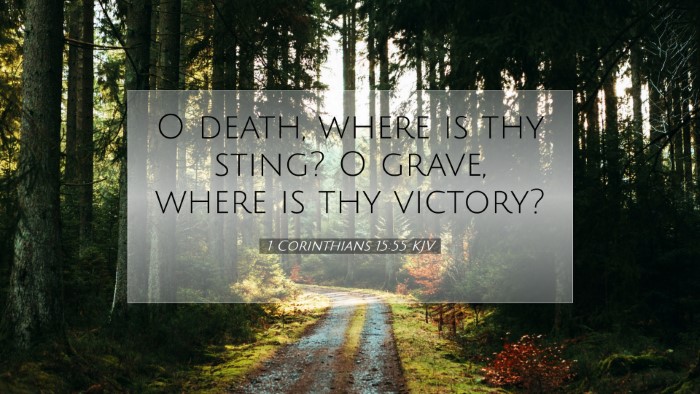Commentary on 1 Corinthians 15:55
Verse: "O death, where is thy sting? O grave, where is thy victory?"
This powerful rhetorical question is set within the context of Paul's discourse on the resurrection of the dead. It serves as a proclamation of victory over death through Jesus Christ. The Apostle Paul, in this verse, draws from the prophetic traditions of the Old Testament and highlights a transformative shift brought about by the resurrection.
Overview and Context
In 1 Corinthians 15, Paul addresses the reality and significance of the resurrection, emphasizing its centrality to Christian faith. The chapter aims to clear the confusion surrounding resurrection and affirm the hope that believers have in Christ's triumph over death.
Insights from Matthew Henry
According to Matthew Henry, this verse encapsulates the ultimate triumph over the final enemy – death. Death is often portrayed as a fierce adversary; however, Paul’s exclamation serves to render it powerless in the light of resurrection. Henry notes:
- The Metaphor of the Sting: Henry elaborates that the "sting" refers to the consequences of sin, where death is described as a punishment for humanity’s fall into sin. But for those who believe in Christ, this sting is removed.
- Victory over the Grave: He emphasizes that the grave (or hell) has no victory over the believer because Jesus has overcome death. Through His resurrection, believers are reassured of their eternal life.
- Exultation in Hope: Henry reflects on the joy and comfort this promise brings to Christians, framing death not as a feared end but a gateway to eternal communion with God.
Insights from Albert Barnes
Albert Barnes provides a detailed exegesis on the verse, focusing on the implications of this question. He notes:
- Rhetorical Impact: Barnes explains that Paul uses a rhetorical style to challenge death and grave, effectively saying that they have been stripped of power and glory for the believer. The use of “where” suggests that the defeat of death renders it devoid of triumph.
- Contextual Reference: He contextualizes Paul’s words by highlighting that they resonate with Isaiah 25:8 and Hosea 13:14, wherein the ultimate defeat of death is foretold. This connection illustrates that the victory through Christ fulfills longstanding prophecies.
- Moral Implications: Barnes points out that by addressing death and the grave with mockery, Paul underscores the call for Christians to live unafraid of physical demise, emphasizing the hope of resurrection and eternal life.
Insights from Adam Clarke
Adam Clarke’s commentary emphasizes the theological and eschatological dimensions of this verse:
- Theological Declaration: Clarke interprets this exclamation as a declaration of confidence from believers in Christ. It asserts that death and the grave are defeated realities for those who possess the assurance of salvation.
- Theological Significance of Resurrection: He elaborates on how Paul contrasts the natural life with the spiritual life brought forth by resurrection, delivering a message of hope and transformation for those in Christ.
- Love Dispelling Fear: Clarke emphasizes that perfect love casts out fear ("1 John 4:18"), meaning that the believer’s assurance in Christ's resurrection dispels the anxiety surrounding death.
Theological Implications
This verse stands as a critical statement concerning the nature of death and resurrection in Christian theology. Here are several key theological implications drawn from the commentaries:
- Victory in Christ: The victory over sin and death is established through Christ's resurrection, accentuating the transformative power of faith.
- Encouragement for Believers: This verse offers spiritual encouragement, revealing that while death is inevitable, it is not the end for believers, thus fostering resilience in times of trial.
- Eschatological Hope: It affirms the Church's belief in resurrection and eternal life, leading to a hopeful outlook on eschatological promises.
Conclusion
1 Corinthians 15:55 serves as more than a mere rhetorical question; it is a profound declaration of the victory over death through Jesus Christ. The insights from public domain commentaries provide a rich tapestry of understanding, revealing the depth and breadth of Paul's message to the Corinthian church and to believers throughout the ages.
As pastors, students, theologians, and Bible scholars engage with this text, let them be reminded of the hope and assurance it brings—transforming fear into joy and despair into triumph.


